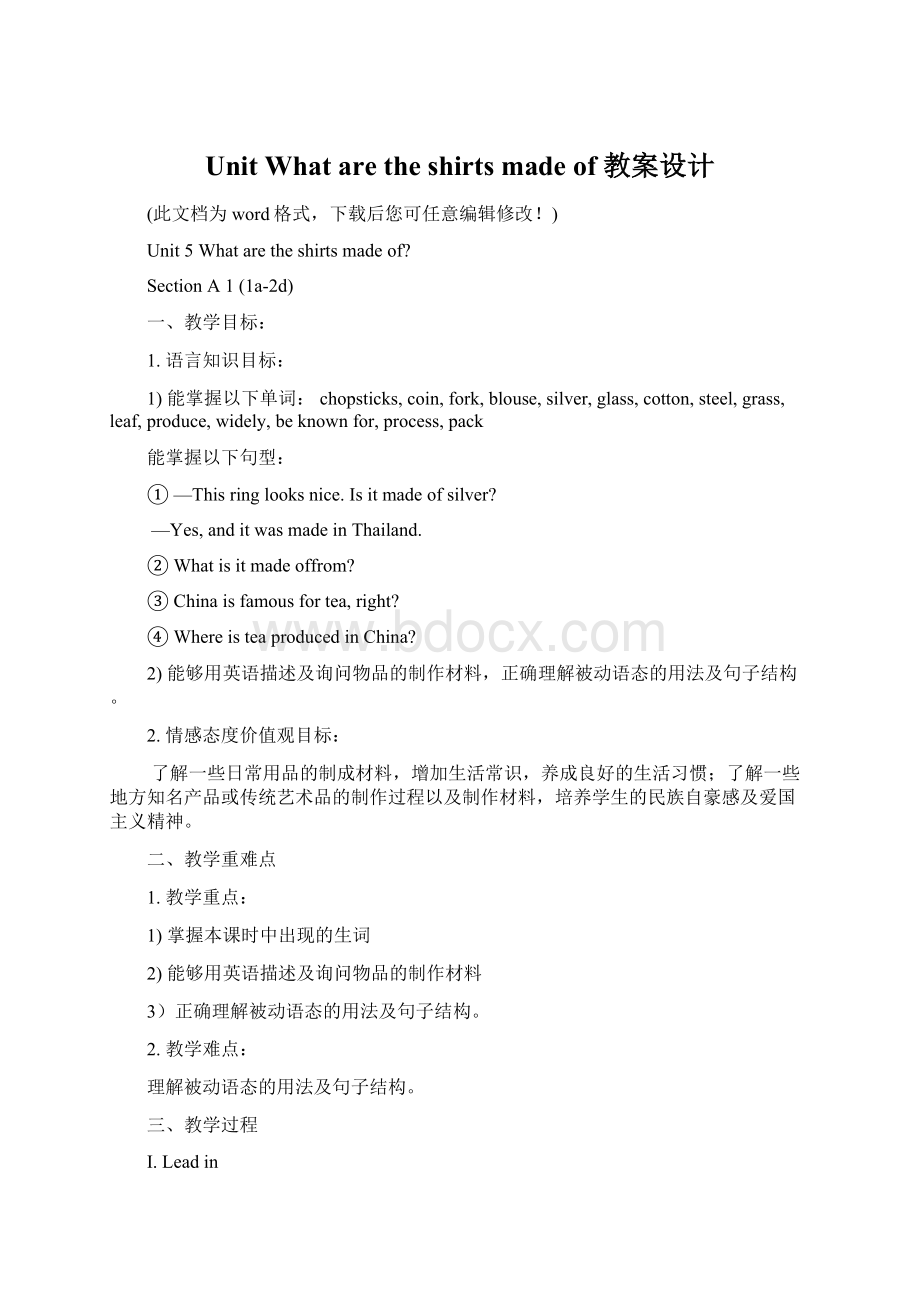UnitWhat are the shirts made of 教案设计Word文件下载.docx
《UnitWhat are the shirts made of 教案设计Word文件下载.docx》由会员分享,可在线阅读,更多相关《UnitWhat are the shirts made of 教案设计Word文件下载.docx(21页珍藏版)》请在冰豆网上搜索。

三、教学过程
Ⅰ.Leadin
1.播放动画片《造纸过程》的视频,让学生们了解这个中国传统发明的情况。
T:
Whoinventedpaperfirst?
S1:
CanLuninventeditinHandynasty.
Whatwaspapermadeofthen?
S2:
Itwasmainlymadeofbamboo.
wasiteasyforpeopletomakepaperthen?
No,itwasverydifficultthen.
Whatispapermadeofnow?
S3:
It’smainlymadeofwood,bamboo,andcotton.
…
Ⅱ.Presentation
1.Presentthesentencestructure,usingthepicturesonthebigscreen:
—What’sthegoldenmedalmadeof?
—It’smadeofgold.
—Isthistablemadeofwood?
—No,itisn’t.It’smadeofglass.
—IsButtermadefrommeat?
—No.It’smadefromcream?
让学生们学习掌握bemadeoffrom句型的用法,及bemadeof与bemadefrom的区别。
两词组都是“由……制成的”之意。
bemadeof指从原料到制成品只发生了形状变化,没有发生本质变化(属物理变化)
bemadefrom指从原料到制成品发生了质的变化,已无法复原(属化学变化)。
Ⅲ.Learning
1.Showsomepicturesonthebigscreen.Trytolearnthenewwordsusing“bemadeof”structure.
Learnthenewwords:
chopsticks,coin,fork,blouse,silver,glass,cotton,steel,grass,leaf
e.g.Thispairofchopsticksaremadeofbamboo.
Thiscoinismadeofsilver.
Isthisblousemadeofcotton?
No,itisn’t.It’smadeofsilk.
What’stheforkmadeof?
It’smadeofsteel.
Thesepigslikegrassverymuch.
apieceofleaf
Kolaslikeleaves.
2.Ssdiscusswiththeirpartnerandtrytolearnthenewwords.
3.GiveSsfivemoreminutestorememberthenewwords.
Workon1a:
LetSsreadthethingsandmaterialsin1a.Discusswiththeirpartnersandmatchthemwiththematerials.Morethanoneanswerispossible.
Whatarethesethingsusuallymadeof?
Matchthemwiththematerials.Morethanoneanswerispossible.
1.chopsticks
2.window
3.coin
4.stamp
5.fork
6.blouse
a.wood
b.gold
c.silver
d.paper
e.silk
f.glass
ChecktheanswerswiththeSs.
Ⅳ.Listening
1.T:
TellSstheywillaboutsomethingsandmaterial.Listenandmatchtheproductswithwhattheyaremadeofandwheretheyweremade.
Things
Madeof
Madein
shirts
cotton
Korea
chopsticks
silver
Thailand
ring
steel
America
2.Letonestudentreadthewordsinthebox,PlaytherecordingfortheSstolisten.
3.Sstrytolistenandmatchthethingswiththematerialand.LetSscheckthefactstheyintheboxin1c.
2.Sstrytomadeconversationsusingtheinformationin1b.
e.g.A:
Yournewshirtlooksverynice.Isitmadeofcotton?
B:
No,itisn’t.It’smadeofsilk.
3.Letsomepairsreadouttheirconversations.
Ⅵ.Listening
Workon2a:
Let’slistentoanotherconversationbetweenNickandMarcus.
1.Whataretheytalkingabout?
First,let’slookatthepicturesandthephrasesin1a.
(Letonestudentsreadthephrasesin2a.)
Listenandcheck(√)themaintopicofNickandMarcus’conversation.
____thesciencemuseum
____theartandsciencefair
____environmentalprotection
____amodelplane
____abeautifulpainting
____grassandleaves
2.PlaytherecordingfortheSstolistenandcheckthephrases.
3.Playtherecordingagaintochecktheanswers.
Workon2b:
1.LetSsreadthesentencesbelow.ExplainsomemainsentencesfortheSs.Makesuretheyknowwhattodo.
2.LetSsreadthequestionsin2b.Makesuretheyunderstandthemeaningofeachquestion.
PlaytherecordingfortheSstoanswerthequestions.(Ifnecessary,usingthepausebutton.)
1)Whereistheartandsciencefair?
_________________________
2)DoNickandMarcustochecktheanswers.
4.Playtherecordingagain.LetSsfillintheblanksoftheconversation.
Ⅶ.Pairwork
1.TellSstomakeaconversationusingtheinformationin2aand2b.
e.g.
A:
Whatdidyouseeattheartandsciencefair?
B:
Isawamodelplane.
Whatisitmadeof?
It’smadeofsteel,glass,andplastic.
2.LetSsmaketheirownconversations.
3.Practicetheirconversationsinpairs.
Ⅷ.Role-play
1.Workon2d
Readtheconversationandcompletetheblanks.
1)Chinese_____________teabothinthepastandnow.
2)_________Iknow,teaplants_________onthesidesofmountains.
3)Whentheleavesareready,they_______by_______forprocessing.
4)Thetea____________andsenttomanydifferentcountriesandplacesaroundChina.
5)Peoplesaythattea_______________somenewwordsandmainpointsintheconversation.
4.AskSstorole-playtheconversationingroups.
X.Languagepoints
1.Whatisthemodelplanemadeof?
Whatisthepaintingmadefrom?
bemadeof与bemadefrom辨析
e.g.Glassismadeofglass.玻璃杯是由玻璃制成的。
Thepaperismadefromwood.纸是木头做的。
2.Forexample,AnxiandHangzhouare
widelyknownfortheirtea.
widelyadv.广泛地;
普遍地
wide(形容词)+ly→widely(副词)
e.g.GasiswidelyusedforcookingandChina?
producev.生产;
制造;
出产
英语中有produce,grow和plant三个动词均可用来描述农作物及植物的“种植;
生产;
生长”,但有所区别。
produce指农作物成产量化地“出产”,或自然地“生长出;
长出;
结出(果实)”。
e.g.Thisregionproducesover50%ofthecountry’srice.
这个地区出产整个国家50%以上的大米。
Thesetreescanproduceverygoodapples.
这些树能结出优质的苹果。
grow表示“种植;
使生长”,着重指种植以后的栽培、生长过程。
e.g.Theseplantsgrowfromseeds.这些植物从种子生长而来。
Thevillagersgrowcoffeeandcorntosellinthemarket.
村民们种植咖啡和玉米好拿到市场上去卖。
plant侧重“栽种;
播种”这一行为,指把种子或秧苗种到土壤里使之生长。
e.g.Howmanytreestheirbackyard.
他们在后院栽种了西红柿和胡萝卜。
3.Forexample,AnxiandHangzhouarewidelyknownfortheirtea.
beknownfor以……闻名;
为人知晓
beknownfor=befamousfor
e.g.Suzhouisknownforitsbeautifulgardens.
苏州以其美丽的园林而闻名于世。
beknownas和beknownfor
beknownas意为“作为……而著名”。
beknownfor意为“因……而著名”。
根据句意用beknownas或beknownfor的适当形式填空。
1)HanHan____________in2dafterschool.
II.Translation.
1.这个戒指是银制的。
2.这种纸是由树木制成的。
3.油漆是由什么制成的。
4.杭州因其茶叶而为人知。
5.据我所知,茶树被种植于山坡上。
SectionA2(3a-3c)
1)学习掌握下列词汇:
France,nomatter,local,brand,avoid,product,
1.AskSstorole-playtheconversationin2d.
2.Checktheonthesidesofthemountains.
Ⅱ.Leadin
1.展示一段伦敦奥运会礼品的视频,让学生了解中国制造已被世界人民所接受。
ThenaskSssomequestions:
Asweknow,therearesomanythingsmadeinChinainEngland.WhataboutinAmericaandothercountriesintheworld?
Nowlet’sreadthepassageof3a.First,readquicklyandfindtheanswertothisquestion:
1)WheredidKangJianvisitlastyear?
2)WeretheremanythingsmadeinChinaintheUS?
3)WhattwothingsdidKangJianwanttobuyintheUS?
4)Whereweretheymade?
Ssreadthearticlequicklyandtrytoanswerthequestions:
2.方法指导:
带着问题,然后快速阅读短文,争取在较短的时间内,找到答案。
3.学生们,按老师指导的方法进行阅读,并快速回答这二个问题。
4.最后,教师让部分学生回答答案,并校对答案。
III.Reading
Workon3b:
1.告诉学生们再次阅读短文内容,并完成3b中的问题。
2.让学生们先读这五个问题,确信所有的学生都能理解这些问题的意思。
3.然后仔细回读短文,在短文的相关信息处划线,并回答出问题。
3.让学生们回答问题,校对答案。
Ⅳ.CarefulReading
Workon3c
1.告诉学生们本学习活动的要求:
写出下列指示代词在短文所指代的事物。
2.让学生们读3d中的内容,理解黑体指示代词所处的句子的意思,及其上下文的意思,开动自己大脑进行思维,确定它们所指的内容。
3.如果不能确定,可以在小组内进行讨论。
4.Checktheanswers.
V.Postreading
AskSstofillintheblankstocompletethepassage.
KangJianisa____________studentfromShanghai.LastyearSanFrancisco.He______itinterestingthatsomany_________inthelocalshops______________China.Shewantedtobuya_________for,buteventhoughmostofthetoyswere_______brands,theyweremadein________.
Readthesecondparagraphandfillintheblanks.
ToysarenottheonlythingsmadeinChina.______,thereweremanyotherthingsmadeinChina--footballs,______________aremadeinChina.He________thatAmericanscould___________________productsmadeinChina.
Hethinksit’sgreatthatChinaissogoodat________these__________________.HewishesthatChinawillalsogetbetteratmaking__________________________inthefuture.Andpeoplecanbuythoseproductsin____________oftheworld.
Sstrytofillintheblanksbythemselves.
VI.Explanations
1.nomatter无论;
不论
nomatter意为“无论”与“what,who,which,where,’tbelieveyou.
无论你说什么,我都不会相信你。
Nomatterwhenyouarefree,youcancomewouldyouliketothecrowd,Samlookedasidetoavoid_________(see)JaneandMary.
4.Isthiskindofbicycle______(make)inShanghai?
5.The______(locally)governmentlistedelderlypersonofno,findit+adj.that…,eventhough,avoiddoingsth.,everydaythings
SectionA3(GrammarFocus-4c)
boss,Germany,surface,material,traffic,postman,cap,glove
2)进行一步复习巩固学习SectionA部分所学的生词和词组。
3)对询问物品的制作材料、生产地点、生产制作过程等语句进行归纳总结和探究学习。
4)掌握被动语态的用法,并通过不同方式的练习,来熟练掌握被动语态。
了解一些日常用品的制成材料,增加生活常识,养成良好的生活习惯;
二、教学重难点
1)复习巩固SectionA部分所学的生词和词组,达到熟练运用的目标。
2)被动语态的用法。
1)探究学习询问物品的制作材料、生产地点、生产制作过程等句型。
Ⅰ.Warming-upandrevision
1.Haveadictationofthenewwordslearnedinthelastclass.
2.Reviewsomemainphraseswelearnedinthelastclass.Checkthe?
②是的,而且它们产于美国。
Yes.Andtheywere________theUS.
③飞机模型是由什么制成?
______themodelplane______of?
④它是由旧木头和玻璃制成。
It’smadeof___________and______
⑤茶产自中国哪里?
___________tea___________inChi